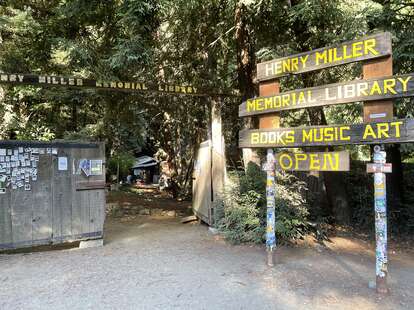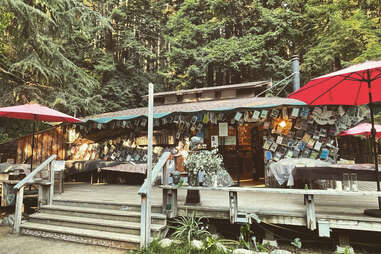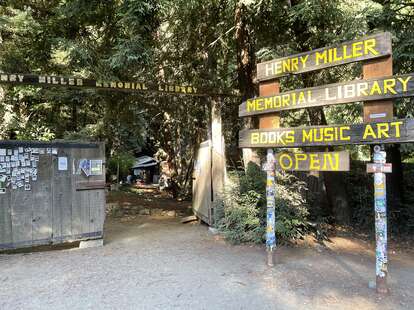
The Henry Miller Memorial Library is a book-lover’s dream. | Photo by Nick Hilden
The Henry Miller Memorial Library is a book-lover’s dream. | Photo by Nick Hilden
I’m driving down the 101 two-and-a-half hours south of San Francisco, through the farmlands of Salinas, past the dunes of Monterey, and skirting a cliff that provides a stunning view of the Pacific—which is lucky, because this stretch of coast is often hidden by mysterious mists. I pass over a series of beautifully arching bridges before the road carries me into a forest, shadowed by giant redwoods.
Here is where the Big Sur region begins: a handful of B&Bs, restaurants, and campgrounds that you’ll miss if you blink. The Lilliputian town of Big Sur is all about its bohemian, off-the-beaten-track atmosphere—a vibe that peaks when you reach a particular wooden house surrounded by trees in a shady ravine just south of town.
Books hang from the roof eaves. They’re tacked to the walls, laid out on tables on the wrap-around deck, and even dangling from the branches of a tree growing in the middle of the porch. This is the Henry Miller Library. Simply put, it is a mecca for book nerds.

American author Henry Miller once lived in this house for several years in the late 1940s. Today it functions mainly as a bookstore, situated in the old living room. The collection of course includes everything by Miller and most of the works of Anais Nin (with whom Miller and his wife had a complicated and steamy relationship). You’ll also find books by Ta-Nehisi Coates, Virginia Wolfe, Haruki Murakami, Ernest Hemingway, Alan Ginsberg, Emily Dickenson, James Baldwin, and many, many others.
The library also acts as a nonprofit to support artists of all walks, providing a workshop and performance space with regular events. There are short film screenings, story competitions, author readings, live music shows, and even the occasional outdoor dinner. The path leading to the bookstore (lined with a smattering of art) brings you past a stage that has hosted the likes of the Red Hot Chili Peppers, the Flaming Lips, Philip Glass, Sharon Van Etten, Yo La Tengo, the Pixies, and Patti Smith.

Passing through a tall wooden fence, the first thing you’ll likely notice is a mailbox bearing the name “Emile White.” He was one of Miller’s best friends and neighbors—as is detailed in Miller’s delightful book Big Sur and the Oranges of Hieronymus Bosch (which, by the way, is a fantastic audiobook to listen to during the drive into town). White went on to preserve the house after the writer’s death. Today the house is covered with colorful chalk scrawlings, and visitors are invited to add to the ever-evolving mural.
Though the library makes for a gorgeous day trip out of San Francisco, the town of Big Sur tempts visitors to stay the night in one of its rustic accommodations. Glen Oaks has hip, vintage-style cabins and rooms where you can feel transported to a plot from another era. Or indulge in adult versions of a Peter-Pan-like fort in the elegant treehouses at The Post Ranch Inn. If you want to go all-bohemian, Alila Ventana really leans into la vie boheme with a clothing-optional pool.

For another kind of escape from reality, there are also several quality campgrounds, arguably the standout being Fernwood, which offers camping, glamping, cabins, a bar and grill, and occasionally live music from some pretty big-name acts.
As part of your literary pilgrimage you should probably eat at Nepenthe, an old haunt of Miller’s that offers California fare and some high-altitude views. Though you could also go for pub food at the Big Sur Taphouse or a solid sandwich at the Big Sur Deli, which also has a general store with local syrup, hot sauce, and jerky.

But there’s one more literary reference waiting in these oceanside peaks. Nearby Salinas was the hometown of author John Steinbeck. There you can visit his grave at the Garden of Memories Memorial Park. In Salinas, you’ll also find the National Steinbeck Center, which provides a deep dive into the great author’s books and films.
Further south in Monterey is Cannery Row, which was the setting for several of Steinbeck’s greatest works. While the Cannery Row of his day was a somewhat sordid, down-and-out place, today its streets are lined with a series of shops and restaurants, some of which extend onto a stilted dock jetting out into the sea.







